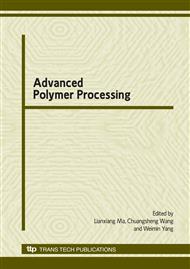p.69
p.74
p.80
p.86
p.92
p.98
p.104
p.110
p.116
Influence of Mineral Admixtures on the Performance of Polymer Modified Porous Concrete
Abstract:
In order to improve the performance of polymer modified porous concrete (PMPC), the mineral admixtures (MAs) including fly ash (FA) and silicon fume (SF), are added in the concrete. In this paper, the optimum dosage of the MAs, the influence of the MAs on the strength performance, permeability performance and the surface functional performance of PMPC are studied. The microscopic test of SEM is used to explore the microscopic structure of PMPC. The test results indicate that: the dosage of 10% FA or of 6% SF is the optimum dosage, while the 28d compressive strength can reach 24MPa and 43MPa, respectively, the 28d flexural strength can reach 5.2MPa and 5.3MPa, respectively, and the permeability coefficient can reach 0.36cm/s and 0.32cm/s, respectively. The surface structural depth can reach more than 1mm and the slide resistance coefficient can reach more than 40BPN, which can conform to the standard of JTG F30-2003. The Contact Element Model is proved to conform to the structural features of PMPC. With the microscopic test, as the addition of the polymer and MAs, the internal micro-cracks and non-hydrated cement particles in the interfacial transition zone (ITZ) are covered by the cement paste and polymer films. The contact area, the mechanical property and durability of PMPC can be improved.
Info:
Periodical:
Pages:
92-97
Citation:
Online since:
December 2009
Authors:
Price:
Сopyright:
© 2010 Trans Tech Publications Ltd. All Rights Reserved
Share:
Citation:


